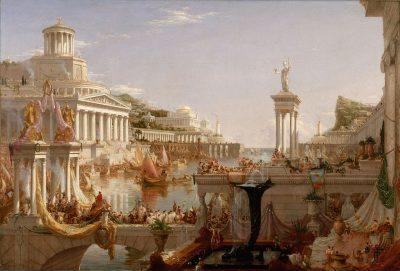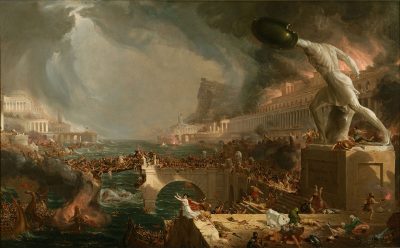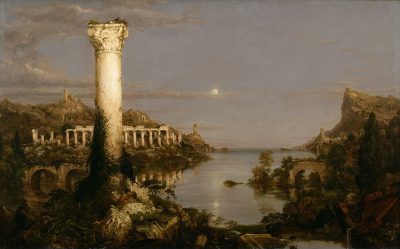 Horace Bushnell needed a vacation. On the first day of July 1845, the Hartford, Conn., clergyman boarded the British packet-ship Victoria and set off for a salaried year in Europe. Weary from preaching trips to New York City, Washington, D.C., North Carolina, and Ohio, along with the publication of a prolific number of tracts, the Congregationalist pulpit star spent his first days at sea slumped in a state of wonder. In his journal, Bushnell noted down the natural and supernatural beauty bordering his view. Here was the diligent ship, “throwing up her head into the air then plunging down the other side of a billow.” And there was the “unearthly blue” water that kept “dancing like a “lively girl.” It all blended into a “solemn, stately roar…like an anthem rising to God from a new-created world.” An exhausted Bushnell, author of the forthcoming Christian Nurture (1847), tried to savor nature’s grace. Mostly, he missed home.
Horace Bushnell needed a vacation. On the first day of July 1845, the Hartford, Conn., clergyman boarded the British packet-ship Victoria and set off for a salaried year in Europe. Weary from preaching trips to New York City, Washington, D.C., North Carolina, and Ohio, along with the publication of a prolific number of tracts, the Congregationalist pulpit star spent his first days at sea slumped in a state of wonder. In his journal, Bushnell noted down the natural and supernatural beauty bordering his view. Here was the diligent ship, “throwing up her head into the air then plunging down the other side of a billow.” And there was the “unearthly blue” water that kept “dancing like a “lively girl.” It all blended into a “solemn, stately roar…like an anthem rising to God from a new-created world.” An exhausted Bushnell, author of the forthcoming Christian Nurture (1847), tried to savor nature’s grace. Mostly, he missed home.
Bushnell traveled frequently along the eastern seaboard as a preacher and proponent of the newly formed Christian Alliance, but this marked the 43-year-old’s first foray abroad. He felt keenly the newness of his experience. As the ocean drew him away from wife Mary
and their three young daughters, Bushnell’s melancholy grew. At first, the great American theologian made for a reluctant explorer. “I go out at the sunsetting and early evening, and hang my legs over the stern of the vessel, and sit with my face to my country and my dear wife and children, with how many and strange thoughts contesting me,” he wrote. “What are they doing? Their conversation? Do they look upon this moon with me?” Over the course of his 20-day voyage, Bushnell’s fog lifted. At the captain’s request, he gave a spontaneous sermon “on the moral uses of the sea.” Bushnell reckoned that God made earth as a moral school for man; God’s oceans split nations and thereby preserved opportunities for cross-cultural discovery. His reasoning was Protestant and patriotic: “I set up for the United States no invidious claim of precedence,” Bushnell said. “We acknowledge our rawness and obscurity, in comparison with the splendor and high refinement of more ancient nations. We only claim it as our good fortune that we are a new nation, peopled by men of a new world, who had new principles to be tested, for the common benefit of mankind.” Transatlantic travel, Bushnell saw, held spiritual medicine.
 Once the Victoria
Once the Victoria
docked at Falmouth, England, Bushnell embarked on a whirlwind tour. He made a pilgrimage through Old World Christianity, with stops in Edinburgh, Geneva, London, and Rome. Shortly before he sailed back to America, Bushnell reflected on the lessons of his year abroad. “I had lived in a sphere where I was everything, had never gone out of my sphere to see how the broad world looked,” he wrote. “Here I am in London, and who am I here? It is good for me—I feel it to be good; in one view, just the thing I wanted. It does not crush me or anything like that; but it shows me what a speck I am.” American travelers in Europe were nothing new in Bushnell’s time, yet their religious journeys need deeper analysis. Raised largely on British books featuring the travelogue as an affirmation of education and self-development, many other “specks,” including Washington Irving, James Fenimore Cooper, Frederick Law Olmsted, Nathaniel Hawthorne, Wendell Phillips, Bayard Taylor, and Ralph Waldo Emerson, all produced notable travel literature. How many, like Horace Bushnell, wondered if a good Christian could also be worldly? Or, as Professor Capper asked us when we paced through The American Intellectual Tradition many moons ago: “What’s at stake here?”
For Bushnell and his peers, foreign travel shaped what I call “cosmopolitan Christianity.” This was a religious consciousness that men and women used to reframe the world for critique while they strove to become better citizens of it. Growing out of the American intellectual tradition of reform, and foreshadowing Gilded Age literature, currents of cosmopolitanism run through the writings of Horace Bushnell, Orestes Brownson, and Harriet Beecher Stowe—to name a few. They excelled as collectors and interpreters of religious culture. And they applied different Christian filters when they considered the spiritual course of empire, at home and abroad. Over the next few weeks, I’ll chart how this cosmopolitan Christianity developed in their letters, and changed their lives. Broadly, cosmopolitanism fostered cultural encounters, widened reading habits, and stirred faith (and doubt) in Americans venturing past familiar havens. The religious aspects of those journeys led them to change their minds about national goals, Christian citizenship, and universal rights. When they remade the world from a cosmopolitan perspective, Bushnell, Brownson, and Stowe found a new set of milestones—and foreign colleagues—ready to gauge American progress. The exchange was a two-way street: the Christian and the cosmos were in conversation. This dialogue would, by century’s end, generate an influential network of transatlantic reformers. Reading Bushnell’s work in 1850, one reviewer for the London Economist
acknowledged that Americans’ brand of Christianity had merit. “Voices on religion and philosophy are coming to us thick and fast from across the Atlantic,” he wrote, all hailing from a place where “the prejudices of Europe do not extend and inquiries there may reach foundations that we rarely think of meddling with.”
 How did these voices gain power through travel? We’ll take a closer look at three major thinkers—a Congregationalist, an evanglical Protestant, and a Roman Catholic—to see how cosmopolitan Christianity played out in their ouput of work and prayer. Bushnell, Brownson, and Stowe used travel to bring some worldliness to American Christianity. Once home, they worked to illustrate scenes of Old World faith and New World practice. All three reasserted the power of Christianity’s moral suasion in a global era of change. Bushnell’s encounter with an eclectic series of foreign believers, for example, took place against the backdrop of political strife and social turmoil fracturing pre-revolutionary Europe. His initial loneliness gave way to his excited discovery of the relative strength of Christianity at home, when he compared it to the state of piety on the Continent. Many of the themes found in Bushnell’s Letter to His Holiness, Pope Gregory XVI (1846), as well his latter sermons on the cultivation of a Christian home, were drawn from his trip. Transatlantic celebrity Harriet Beecher Stowe, crossing to England seven years later, embraced the religiosity of her journey right from the start, joining her younger brother Charles on the ship’s deck to shout hymns like Amazing Grace into the “roaring winds and waves.” After touring castles and cathedrals in the “sunny” lands of Europe, Stowe swung back to New England culture and theology in Oldtown Folks
How did these voices gain power through travel? We’ll take a closer look at three major thinkers—a Congregationalist, an evanglical Protestant, and a Roman Catholic—to see how cosmopolitan Christianity played out in their ouput of work and prayer. Bushnell, Brownson, and Stowe used travel to bring some worldliness to American Christianity. Once home, they worked to illustrate scenes of Old World faith and New World practice. All three reasserted the power of Christianity’s moral suasion in a global era of change. Bushnell’s encounter with an eclectic series of foreign believers, for example, took place against the backdrop of political strife and social turmoil fracturing pre-revolutionary Europe. His initial loneliness gave way to his excited discovery of the relative strength of Christianity at home, when he compared it to the state of piety on the Continent. Many of the themes found in Bushnell’s Letter to His Holiness, Pope Gregory XVI (1846), as well his latter sermons on the cultivation of a Christian home, were drawn from his trip. Transatlantic celebrity Harriet Beecher Stowe, crossing to England seven years later, embraced the religiosity of her journey right from the start, joining her younger brother Charles on the ship’s deck to shout hymns like Amazing Grace into the “roaring winds and waves.” After touring castles and cathedrals in the “sunny” lands of Europe, Stowe swung back to New England culture and theology in Oldtown Folks
(1869) with a very different gaze. “Never have I so truly felt the unity of the Christian church, the oneness of the great family in heaven and on earth,” Stowe recalled, “as in the experience of this journey.”
Cosmopolitan Christians found their new views often opened political channels, even without crossing the ocean. The influential activist Orestes Brownson traveled and wrote widely, but he never made it to Rome. Brownson became the American Catholic mostly closely associated with it, enduring strong reactions to his views on faith, labor, and reform. Like Bushnell, Brownson’s explorations convinced him that church and state in America were organically linked, such that “society stands nearer to God, and participates more immediately of the Divine essence, and [that] the state is a more lively image of God than the individual.” That was the credo laid down in his American Republic: Its Constitution, Tendencies, and Destiny (1866), a platform where Brownson sought a new communion between the North and the South following the Civil War’s fury. When they looked to Europe, Christian ideas and culture equipped Brownson, Bushnell, and Stowe with some perspective from which to interpret and (hopefully) to improve society. So they moved about the modernizing world, testing that religious inheritance. They gawked at glaciers, patted saints’ bones, and hummed along to familiar hymns in foreign cathedrals. And they came home, wondering: Was Christianity still the best tool for carving out America?
Next: The Puritan’s Grand Tour
[These artworks are a selection from Thomas Cole’s five-part series, “The Course of Empire,” (1833-1836), depicting stages of consummation, destruction, and isolation. To learn more, check out these terrific web resources at New-York Historical Society and travel to this excellent interactive site created by the Thomas Cole National Historic Site].

One Thought on this Post
S-USIH Comment Policy
We ask that those who participate in the discussions generated in the Comments section do so with the same decorum as they would in any other academic setting or context. Since the USIH bloggers write under our real names, we would prefer that our commenters also identify themselves by their real name. As our primary goal is to stimulate and engage in fruitful and productive discussion, ad hominem attacks (personal or professional), unnecessary insults, and/or mean-spiritedness have no place in the USIH Blog’s Comments section. Therefore, we reserve the right to remove any comments that contain any of the above and/or are not intended to further the discussion of the topic of the post. We welcome suggestions for corrections to any of our posts. As the official blog of the Society of US Intellectual History, we hope to foster a diverse community of scholars and readers who engage with one another in discussions of US intellectual history, broadly understood.
Thanks for this, Sara! I look forward, with glee, to the series, but especially the entry on Brownson—one of my favorite nineteenth-century figures. – TL